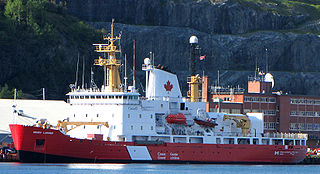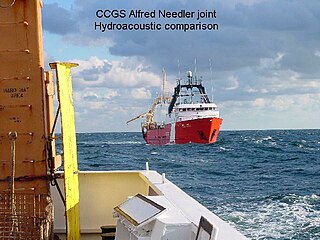
Marine Atlantic Inc. is an independent Canadian federal Crown corporation which is mandated to operate ferry services between the provinces of Newfoundland and Labrador and Nova Scotia.

A ghost ship, also known as a phantom ship, is a vessel with no living crew aboard; it may be a fictional ghostly vessel, such as the Flying Dutchman, or a physical derelict found adrift with its crew missing or dead, like the Mary Celeste. The term is sometimes used for ships that have been decommissioned but not yet scrapped, as well as drifting boats that have been found after breaking loose of their ropes and becoming carried away by the wind or the waves.

CCGS Henry Larsen is a Canadian Coast Guard Improved Pierre Radisson-class icebreaker serving in the Newfoundland and Labrador region and based in St John's, Newfoundland and Labrador. Entering service in 1988, Henry Larsen is the fourth ship and of an improved design over the rest of the ships in her class. The ship operates in the Arctic Ocean during summer months.

Effie M. Morrissey is a schooner skippered by Robert Bartlett that made many scientific expeditions to the Arctic, sponsored by American museums, the Explorers Club and the National Geographic Society. She also helped survey the Arctic for the United States Government during World War II. She is currently designated by the United States Department of the Interior as a National Historic Landmark as part of the New Bedford Whaling National Historical Park. She is the State Ship of Massachusetts.

MV Northern Ranger was a Canadian ice-breaking coastal ferry operating in Newfoundland and Labrador. The ship entered service in 1986 for coastal service in Labrador. The vessel provided service between Nain, Newfoundland and Labrador and Happy Valley-Goose Bay, stopping at points between. The ferry was owned and operated by the province of Newfoundland and Labrador. At the end of 2018, the ship was taken out of service and replaced by a newer vessel on the route between Nain and Happy Valley-Goose Bay.

CCGS Hudson was an offshore oceanographic and hydrographic survey vessel operated by the Canadian Coast Guard. The ship entered service in 1963 with the Canadian Oceanographic Service, stationed at the Bedford Institute of Oceanography, called CSS Hudson. The ship made several significant scientific voyages, among them the first circumnavigation of the Americas in 1970. The ship was transferred to the Canadian Coast Guard in 1996 and decommissioned in 2022. A replacement is not scheduled for delivery until 2024–2025.

CCGS Alfred Needler was an offshore fishery science vessel operated by the Canadian Coast Guard. The vessel entered service in 1982 with the Department of Fisheries and Oceans, stationed at the Bedford Institute of Oceanography in Dartmouth, Nova Scotia. In 1995, in order to reduce the number of ships and combine tasks, the Fisheries and Oceans fleet and the Canadian Coast Guard fleets were merged under the Canadian Coast Guard.

RV Atlantis is a Thomas G. Thompson-class oceanographic research ship, owned by the US Navy and operated by the Woods Hole Oceanographic Institution as part of the University-National Oceanographic Laboratory System (UNOLS) fleet. She is the host vessel of DSV Alvin. She is named for the first research vessel operated by WHOI, the sailboat RV Atlantis, for which the Space ShuttleAtlantis is also named.
Peter Troake, was a mariner, born in Durrell, Twillingate, Dominion of Newfoundland. He was captain of the MV Christmas Seal and recipient of the Order of Canada for his work in the improvement of welfare in Newfoundland through his service to the province of Newfoundland.

413 Transport and Rescue Squadron is an air force squadron of the Canadian Armed Forces. It was originally a flying boat squadron of the Royal Canadian Air Force during the Second World War. It currently operates the C-130 Hercules and the CH-149 Cormorant in transport plus search and rescue roles at CFB Greenwood.

CSS Acadia is a former hydrographic surveying and oceanographic research ship of the Hydrographic Survey of Canada and its successor the Canadian Hydrographic Service.

MV Atlantic Vision is a fast ro-pax ferry owned by the Estonian ferry company Tallink, under charter to Canadian operator Marine Atlantic. In February 2015, Marine Atlantic announced that the lease on the vessel had been renewed until November 2017 for a cost of Can$40 million. It was subsequently extended again, and the vessel is under Marine Atlantic control through November 2019. As of 2016 Atlantic Vision operates on Marine Atlantic's services between North Sydney, Nova Scotia, and the Newfoundland ports of Channel-Port aux Basques and Argentia, Placentia.

USS Yakutat (AVP-32) was a United States Navy Barnegat-class small seaplane tender in commission from 1944 to 1946. Yakutat tended seaplanes in combat areas in the Pacific during the latter stages of World War II. After the war, she was in commission in the United States Coast Guard from 1948 to 1971 as the Coast Guard cutter USCGC Yakutat (WAVP-380), later WHEC-380, seeing service in the Vietnam War during her Coast Guard career. Transferred to South Vietnam in 1971, she was commissioned into the Republic of Vietnam Navy as the frigate RVNS Trần Nhật Duật (HQ-03). When South Vietnam collapsed in 1975 at the end of the Vietnam War, she fled to the Philippines, where the Philippine Navy took custody of her and cannibalized her for spare parts until discarding her in 1982.

USCGC Mendota (WHEC-69) was an Owasco class high endurance cutter built for World War II service with the United States Coast Guard. The ship was commissioned three months before the end of the war and did not see combat action until the Vietnam war.
The Alphabet Fleet was a fleet of vessels owned and operated by the Reid Newfoundland Company as part of the provisioning of the 1898 Railway contract between the Dominion of Newfoundland and the Reid Newfoundland Company. The vessels were named after places in Scotland, the native homeland of Sir Robert Gillespie Reid, founder of the Reid Newfoundland Company.

USS Rockaway (AVP-29), later AG-123, was a United States Navy Barnegat-class seaplane tender in commission from 1943 to 1946. She served in both the Atlantic Ocean and the Pacific Ocean during World War II. In 1948, she was loaned to the United States Coast Guard, in which she served as the cutter USCGC Rockaway (WAVP-377), later WAGO-377, WHEC-377, and WOLE-377, from 1949 to 1972.

USCGC Marion (WSC-145), was a 125 ft (38 m) United States Coast Guard Active-class patrol boat in commission from 1927 to 1962. She was named for Francis Marion, an American Revolutionary War general who was known for his unconventional warfare tactics. Marion served during the Rum Patrol and World War II performing defense, law enforcement, ice patrol, and search and rescue missions. Most notably, Marion served as the platform for the first intensive oceanographic studies made by the Coast Guard.

Crash boats, at the time known as "aircraft rescue boats" or "air-sea rescue boats", were United States high speed boats built to rescue the crew of downed Allied aircraft during World War II. US boats came from the observation of British experience with high-speed launches (HSL) by the Royal Air Force Marine Branch during the Battle of Britain.

MV Marvita also known as HMCS Marvita (Z44) was a former rum runner, Royal Canadian Navy auxiliary vessel, and customs vessel that operated from 1930 until it ran aground and sank on 15 July 1954.
















